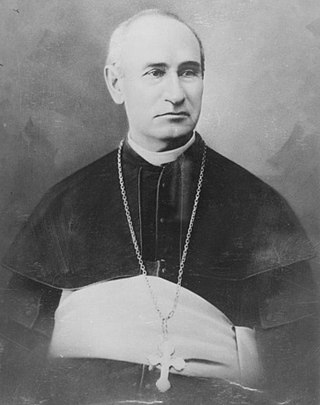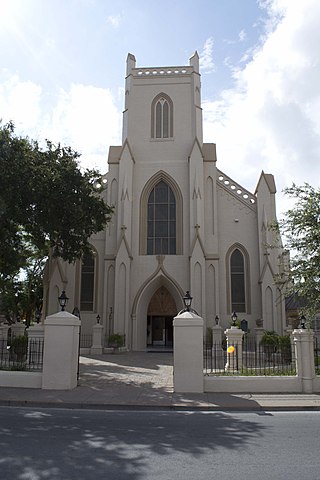
King Ranch is the largest ranch in the United States. At some 825,000 acres it is larger than the land area of Rhode Island and the European country Luxembourg. It is mainly a cattle ranch, but also produced the Triple Crown winning racehorse Assault.

The Missionary Oblates of Mary Immaculate (OMI) is a missionary religious congregation in the Catholic Church. It was founded on January 25, 1816, by Eugène de Mazenod, a French priest later recognized as a Catholic saint. The congregation was given recognition by Pope Leo XII on February 17, 1826. As of January 2020, the congregation was composed of 3,631 priests and lay brothers usually living in community. Their traditional salutation is Laudetur Iesus Christus, to which the response is Et Maria Immaculata. Members use the post-nominal letters, "OMI".

Saint Joseph Academy, sometimes referred to as St. Joe or SJA, is a private school conducted by the Marist Brothers of the Schools. It is located in Brownsville, Texas, United States, and serves junior high and high school students of the lower Rio Grande Valley and Matamoros, Tamaulipas, Mexico. The school is located in the Roman Catholic Diocese of Brownsville.

Circuit riders were clergy assigned to travel around specific geographic territories to minister to settlers and organize congregations. Circuit riders were clergy in the Methodist Episcopal Church and related denominations, although similar itinerant preachers could be found in other faiths as well, particularly among minority faith groups. They were most prominent during the early years of the United States, from 1784–1830, and were part of the Second Great Awakening revival movement.

Charles Stillman was the founder of Brownsville, Texas, and was part owner of a successful river boat company on the Rio Grande.

Dominic Manucy was an American prelate of the Catholic Church. He served as the first Vicar Apostolic of Brownsville from 1874 until his death in 1885, and also served as the third Bishop of Mobile for a few months in 1884.

The Diocese of Brownsville is a Latin Church diocese in southeastern Texas in the United States.

Bagdad was a town established in 1848 on the south bank of the mouth of the Rio Grande, in Mexico. Because the town was inside the municipality of Matamoros, Tamaulipas, it was also known as the Port of Bagdad or the Port of Matamoros. It was officially declared non-existent in 1880.

Juan Alamia was an American soldier who served as a Rough Rider in the Spanish–American War.
Jean-Fleury Baudrand, O.M.I., was a French Roman Catholic priest and missionary who served in North America, where he died.

Immaculate Conception Cathedral is a historic church at 1218 East Jefferson Street in Brownsville, Texas, United States. It is the cathedral church for the Roman Catholic Diocese of Brownsville. It was built in 1856 and added to the National Register of Historic Places in 1980 as Immaculate Conception Church.
Philip Ruh, O.M.I. was Catholic priest and church architect. Although he was educated as a Belgian Oblate, he is remembered for his work in Canada with the Eastern Catholic Ukrainian Canadian community building over forty Byzantine Rite churches and several grottos in a unique architectural style that mixed Byzantine, Latin, and modern Canadian influences. The style is often called prairie cathedral, which is a common nickname for several of his churches, even though only two of them are properly cathedrals.
The following is a timeline of the history of the city of Brownsville, Texas, USA.

La Lomita Chapel is a historic Catholic chapel in Mission, Texas. It was once an important site for the Cavalry of Christ, a group of priests who traveled long distances on horseback to minister to Catholics living on isolated ranches along the Rio Grande.

Pierre Yves Kéralum OMI (1817–1872) was a French-born Catholic missionary and member of the Missionary Oblates of Mary Immaculate. He served in South Texas from 1853 to 1872, traveling long distances on horseback to minister to Catholics living on isolated ranches along the Rio Grande. He was also an architect who designed many buildings in the area, including the Immaculate Conception Cathedral in Brownsville, Texas.

Norma Pimentel, MJ is a Mexican-American nun of the Missionaries of Jesus and the executive director of Catholic Charities of the Rio Grande Valley. She has been praised by Pope Francis and others for her work with refugees and immigrants to the United States. She has also gained international attention for her work and for speaking out against the Trump administration family separation policy.
Kenedy Ranch, also called La Parra Ranch, is located in Kenedy County, Texas. It was established in 1882 by Mifflin Kenedy, a steamboat operator and rancher. His friend and business partner, Richard King, established the adjoining King Ranch. It began as a cattle ranch, but it has found other sources of revenue, including guided hunting and wind farms, due to the changing economy. The town of Sarita was founded in 1904 on land that had been owned by the Kenedy Farm.













